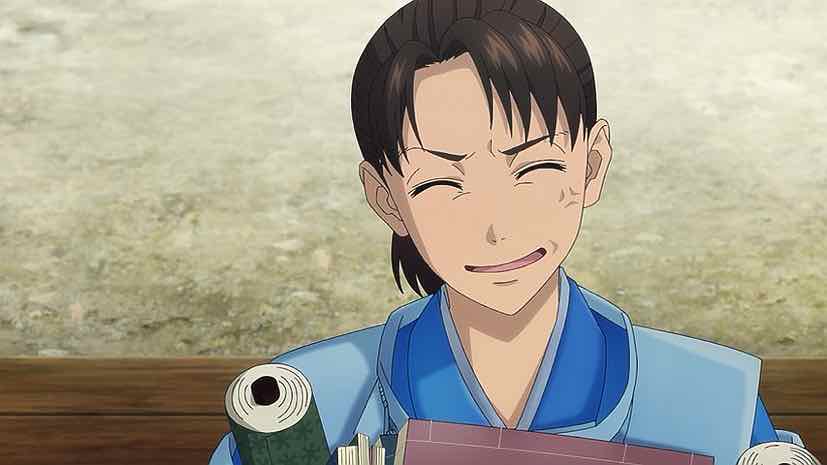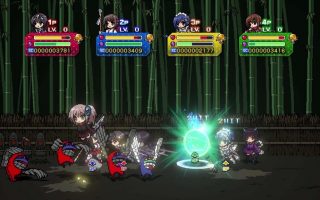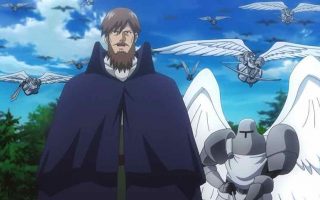Looking at the whole picture, Karasu wa Aruji o Erabanai is probably the best series of the season to this point. It’s still a bit too explain-y at times (FFS show, don’t tell – trust us, we’ll figure it out). But apart from that, this show pretty much covers all the fantasy bases. Great soundtrack (including OP and ED), compelling characters, fascinating premise and elite world-building. One could sense something about this series, a grandness and literary ambition that anime doesn’t display all that often. Yatagarasu has a long way to go yet and many pitfalls to avoid on the way, but early returns are extremely promising indeed.
At the core of all this are two characters and the very fine seiyuu behind them. Wakamiya (the Crown Prince’s actual name) is a bit of a departure for Irino Miyu. He’s terse, devious, rather joyless in his manner. But Irino is one of the best ever and this is no problem for him. As Yukiya, Tamura Mutsumi is very much in her comfort zone – few women play boys this age as effortlessly as she does. Yukiya is the crucial role here – it’s effectively his eyes through which we see these events. He’s a child at the cusp of becoming something more – too smart for his own good in the way clever boys this age often are. Smart enough to know a great many things, not smart enough to realize there are a great many more he doesn’t.
That knowledge will come in time – that’s the nature of experience. But only if Yukiya survives long enough, and in this setting that’s no sure thing. Wakamiya immediately puts him through the wringer, giving the lad a laundry list of assignments seemingly impossible for him to complete in a day (even with wings). Partly this is a test to be sure – to confirm what the Prince already suspects about him, surely, that he doesn’t give up easily. But also whether Yukiya’s cleverness extends to the practical, such as prioritizing the myriad chores he’s been tasked with. One wonders whether that business with different colored pots was merely part of the test (though it’s hinted that there was a legitimate reason behind it).
The Prince is a tough one to get a read on, but it’s obvious that he’s not naive to the forces arrayed against him. He refuses to go to the Cherry Blossom Palace and meet with his prospective consorts, and frequents the pleasure quarter. But he has good reason for this, if his sources are correct – there’s apparently an assassin in the palace waiting for the chance to take him down. The Empress is obviously plotting against him, and it’s worth remembering that it was her son (the elder prince) who suggested – for reasons yet unknown, though I won’t rule out that Natsuka secretly supports his brother – that Yukiya go into Wakamiya’s service.
All this business about a “true Kin’u” and what it represents is certainly central to the plot. It seems likely that Wakamiya is indeed a true Golden Raven and that the birth of one is rare, but it’s less clear whether the rumors about a Kin’u being a harbinger of ill developments is rooted in history or propaganda. It doesn’t take much imagination to see the benefit in spreading such legends, both for the Natsuka fashion now and for power-seekers in the past. A full-on struggle for the throne seems to be developing here, and by appearances Wakamiya is genuinely determined to claim what he sees as rightfully his.
Yukiya manages to survive the initial onslaught of labor Wakamiya dumps on him, but the Prince seems determined to get him killed anyway. He drags the boy along on a spying mission to the Sakura Palace to try and determine whose intentions are hostile. But the reason why becomes clear soon enough, as Wakamiya sacrifices his pawn as soon as things go awry. Asebi steps in calling for restraint when it seems as if the palace guards are going to drown Yukiya, but all present are shocked when he transforms in front of the noble ladies. That, it seems, is something they’re never supposed to see – for reasons that will become clear shortly. Sumio was standing by to save him if things got really bad, he claims, but this still represents quite a baptism by fire for the young yatagarasu.
There’s a lot to unpack here. This revelation about the “horses” being poor yatagarasu effectively sold into slavery is a real game-changer, in my opinion. It may very well cast Wakamiya in the eventual role of social reformer (and thus explain the hostility towards him), though that’s conjecture at this point. I’d also note that it was the first time Asebi has seen Yukiya, and that they’re about the same age – notable as she seems to be the main focus of the B-plot, and is awfully young for the Crown Prince (though in reality that would not be unusual). It’s a setup veritably overflowing with narrative possibility, and there’s nothing to suggest that both the source material and the adaptation are anything less than full capable of realizing it.
The post Karasu wa Aruji o Erabanai (YATAGARASU: The Raven Does Not Choose Its Master) – 03 appeared first on Lost in Anime.




